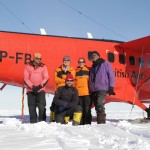Written by Mike Fedak. After a long stretch of physical oceanographic work, on February 23rd, we got a suitable time window to once again try to catch seals and attach CTD-SRDLs. Our original plan was to tag roughly 8 elephant seals and 8 Weddell seals, but until the last few days we had only applied… Read more »
Read Full »New research on Pine Island Glacier published
New research has been published suggesting Pine Island Glacier will continue thinning at its current rate for decades to come. The study, a collaborative project funded by NERC, also suggests the Glacier thinned rapidly 8000 years ago. You can read more here: http://www.antarctica.ac.uk/press/press_releases/press_release.php?id=2514
Read Full »
The iSTAR D team describe how their mission went
iSTAR D Three Brits, a Canadian and an Aussie head off into the Ellsworths… As part of the iSTAR-D project, three GPS receivers were permanently installed throughout the Ellsworth Mountain region of West Antarctica. These receivers, combined with sampling of erratic boulders, aim to provide more information on local ice history and rates of isostatic… Read more »
Read Full »Working in an extreme environment
Whilst we’ve been out of main internet contact, we have still been receiving daily news reports of what’s going on back at home – and the weather in the UK has been consistently making headline news. Although we don’t have constant rainfall (as Antarctica is the driest continent on Earth), we have had our fair… Read more »
Read Full »Weather in Antarctica
Antarctica is the coldest continent on Earth; snow and ice cover 98% of the land surface! Recently, satellite data recorded a new record low temperature of below -90
Read Full »